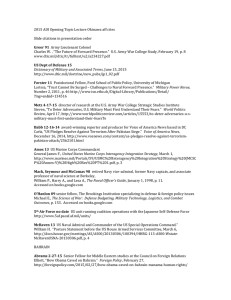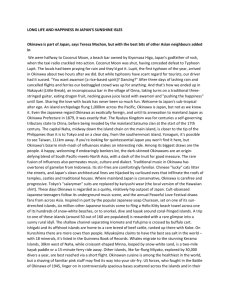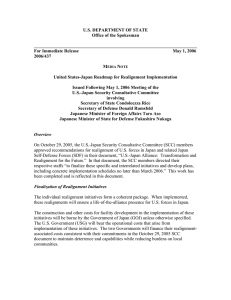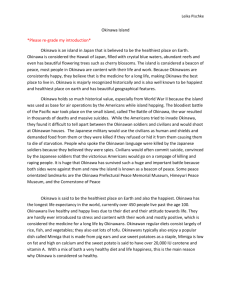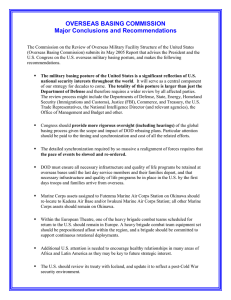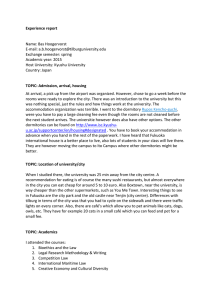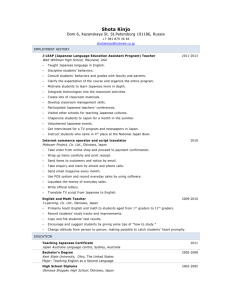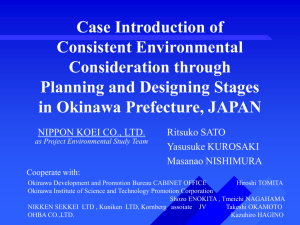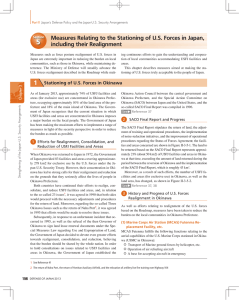5. Force Posture Realignment, Including USFJ (the Third... (1) Outline
advertisement
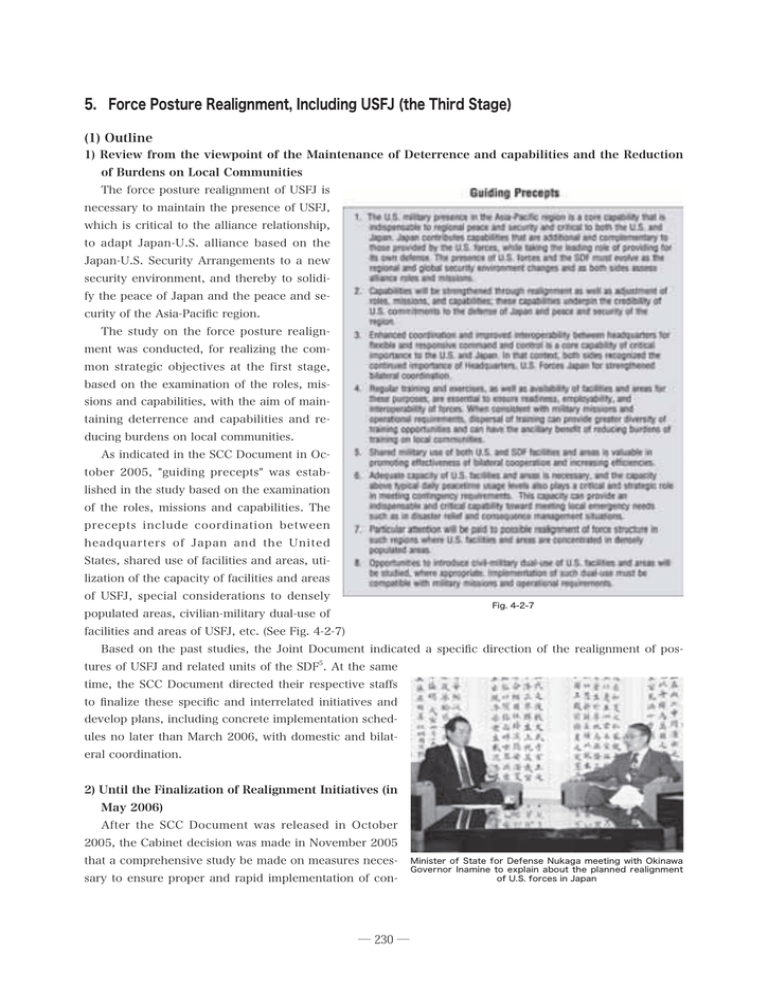
5. Force Posture Realignment, Including USFJ (the Third Stage) (1) Outline 1) Review from the viewpoint of the Maintenance of Deterrence and capabilities and the Reduction of Burdens on Local Communities The force posture realignment of USFJ is necessary to maintain the presence of USFJ, which is critical to the alliance relationship, to adapt Japan-U.S. alliance based on the Japan-U.S. Security Arrangements to a new security environment, and thereby to solidify the peace of Japan and the peace and security of the Asia-Pacific region. The study on the force posture realignment was conducted, for realizing the common strategic objectives at the first stage, based on the examination of the roles, missions and capabilities, with the aim of maintaining deterrence and capabilities and reducing burdens on local communities. As indicated in the SCC Document in October 2005, "guiding precepts" was established in the study based on the examination of the roles, missions and capabilities. The precepts include coordination between headquarters of Japan and the United States, shared use of facilities and areas, utilization of the capacity of facilities and areas of USFJ, special considerations to densely Fig. 4-2-7 populated areas, civilian-military dual-use of facilities and areas of USFJ, etc. (See Fig. 4-2-7) Based on the past studies, the Joint Document indicated a specific direction of the realignment of postures of USFJ and related units of the SDF5. At the same time, the SCC Document directed their respective staffs to finalize these specific and interrelated initiatives and develop plans, including concrete implementation schedules no later than March 2006, with domestic and bilateral coordination. 2) Until the Finalization of Realignment Initiatives (in May 2006) After the SCC Document was released in October 2005, the Cabinet decision was made in November 2005 that a comprehensive study be made on measures necessary to ensure proper and rapid implementation of con- ― 230 ― Minister of State for Defense Nukaga meeting with Okinawa Governor Inamine to explain about the planned realignment of U.S. forces in Japan Chapter 4 Strengthening of the Japan-U.S. Security Arrangements crete the initiatives. The Government of Japan as a whole addressed this task by holding meetings attended by Ministers involved in the realignment of the bases of USFJ. Even the Minister of State for Defense himself visited local governments where U.S. military bases are located, and explained to them the details in good faith to obtain their understanding and cooperation. Japan and the United States frequently held consultations, including those of working-level officials. Japan-U.S. defense ministers meeting was held in January and April 2006. 3) Finalization of Realignment Initiatives At the "2+2" meeting held on May 1 this year, Japan and the United States finalized the force posture realignment in a document titled "Japan-U.S. Roadmap for Realignment Implementation,("Roadmap") and indicated the details for implementing concrete initiatives. (See Fig. 4-2-8 and Fig. 4-2-9) [Initiatives to Maintain Deterrence and Capabilities] Initiatives to maintain Deterrence include: ・ Realignment of the U.S. Army headquarters in Japan ・ Improvement of coordination between headquarters of the SDF and USFJ by collocating headquarters of two countries at Yokota Air Base and Camp Zama of USFJ; ・ Improvement of Interoperability by relocating air training from U.S. forces Kadena Air Base etc. to bases of the Air Self-Defense Force (ASDF); ・ Shared use of facilities and areas of Camp Hansen and Kadena Air Base in Okinawa between Japan and the United States; ・ Deployment of a new U.S. Forward Based X-band radar-Transportable (FBX-T) at ASDF Shariki Subbase. Above-mentioned initiatives will contribute to the improvement of the capabilities of the Japan-U.S. alliance, and the securing of the foundation based on which the SDF and U.S. Forces will respond to various challenges in cooperation with each other. [Initiatives to Reduce Burdens on Local Communities] Initiatives to reduce burdens on local communities in Okinawa include a series of following initiatives: ・ Relocation and return of Futenma Air Station ・ Relocation of U.S. marine personnel and their dependents stationed in Okinawa to Guam; ・ Return of significant land in the densely populated areas south of Kadena Air Base. Other initiatives: ・ Relocation of Carrier Air Wing from Atsugi Air Facility to Iwakuni Air Station as consideration to densely populated areas; ・ Partial return of Camp Zama and U.S. Forces Sagami General Depot; ・ nitiatives related to airspace and air traffic control, including the partial return of Yokota airspace. The relocation of aircraft training from facilities including Kadena Air Base will contribute to reducing impacts by training activities on local communities. Implementation of above-mentioned initiatives will be considered to reduce burdens on Japan as a whole. Even after approximately 8,000 marine personnel in Okinawa relocate to Guam, the deterrence and capabilities of USFJ will be maintained because certain initial operation capabilities are maintained in Okinawa and mobility is expected to be improved by the use of air transportation and high speed vessels. [Costs for Implementation of Realignment Initiatives] In accordance with Article 24 of the Status of Forces Agreement (SOFA) 6, the construction and other ― 231 ― costs for facility development in the implementation of these initiatives will be borne by the Government of Japan unless otherwise specified in the Japan-U.S. Roadmap for Realignment Implementation. The U.S. Government will bear the operational costs that arise from the implementation of these initiatives. Since the realignment of USFJ is an important task to reduce burdens on local communities mainly including Okinawa while maintaining deterrence and capabilities of USFJ, it is decided that proper budgetary measures will be taken after having examined the particulars of costs borne by Japan. The particulars of these realignment initiatives are as follows. (2) Force Posture Realignment in Okinawa At present, many U.S. bases are located in Okinawa. In terms of space occupied, approximately 75% of the facilities and areas of USFJ is concentrated in Okinawa. In particular, U.S. Marine Corps in Okinawa with high mobility and readiness play multiple roles in defending Japan, and in maintaining the peace and security of the region, including responses to tsunami disasters occurred in the Indian Ocean in December 2004 and landslide disasters broken out in the Philippines in February this year, and the earthquake that took place in Java, Indonesia in May this year. As part of its global military posture realignment effort, the U.S. is making several changes to strengthen its force structure in the Pacific. Among these changes are a strengthening of Marine Corps crisis response capabilities and a redistribution of those capabilities that will provide greater flexibility to respond with appropriate capabilities according to the nature and location of particular situations. These changes will also enable increased theater security cooperation with countries of the region, thereby improving the overall security environment. In connection with this realignment, an integrated set of interrelated measures that will also substantially reduce burdens in Okinawa is identified as follows. 1) Futenma Replacement Facilities(FRF) U.S. Marine Corps Futenma Air Station fulfills the following functions: i) To transport ground units of Marine Corps by helicopters etc.; ii) To operate tanker aircraft; iii) To accommodate aircraft in case of emergency. Local residents have strongly demanded the early return of Futenma Air Station, based on their concerns on safety, noise and transportation since it is located in the residential area. Therefore, the following initiatives will be implemented on the functions of Futenma Air Station, and then the air station will be returned. a. Futenma Replacement Facility (Function to transport of ground units of Marine Corps by Helicopters etc.) [Status of Basic Plan Based on the SACO Final Report] The Government of Japan has consistently made efforts to realize the relocation and return of Futenma Air Station as soon as possible. At a meeting held between the then Prime Minister Hashimoto and the then U.S. Ambassador to Japan Mondale in April 1996, the two countries agreed to totally return Futenma Air Station after an adequate replacement facility is completed within five to seven years. Based on this agreement, the Special Action Committee on Okinawa (SACO) Final Report was compiled in December 1996. At the end of 1999, the Cabinet decision was made on a policy that the construction site would be "coastal area of Henoko in Nago City in Camp Schwab Water Area." As a result of discussions at the "Consultative Body on Futenma Replacement Facility" held between the GOJ and local municipalities, in 2002, the Basic ― 232 ― Chapter 4 Strengthening of the Japan-U.S. Security Arrangements Fig. 4-2-8(1) ― 233 ― Fig. 4-2-8(2) ― 234 ― Chapter 4 Strengthening of the Japan-U.S. Security Arrangements Fig. 4-2-9 Waters off Camp Schwab (Henoko) Minister of State for Defense Nukaga and Nago Mayor Shimabukuro shaking hands after their meeting Plan of the FRF was developed. At this stage, more than six years had passed since the agreement of the return. After that, although environmental impact assessment procedure was started in 2004, the return has not been realized within the originally scheduled time of five to seven years. On the other hand, it was expected that it would take another ten years or so to relocate and return the Futenma Air Station for the following reasons. ・ After the Basic Plan was developed, a technical site survey had been conducted since 2003 as necessary procedure for commencement of construction, but the process had not been proceeding smoothly. In addition, it was expected that the environmental impact assessment procedure started in April 2004, and others would take approximately another three years. ・ It was expected that the construction of the FRF would take nine and a half years. In addition, a helicopter accident took place in Ginowan City in August 2004. The potential risk arising from the fact that Futenma Air Station is located in the residential area become evident and renewed the recognition that the early relocation and return of Futenma Air Station was essential. ― 235 ― In due consideration of above-mentioned matters, in order to drive away a general feeling of unrest among local residents, a study on the method to realize early relocation and return of the Futenma Air Station in order to drive away a general feeling of unrest among local residents has been made again during the course of Japan-U.S. consultations on force posture realignment. (See Fig. 4-2-10) [Basic Concepts in the Study on the Location of the FRF] Marine Corps forces consist of air, ground, logistics and command elements, and the interaction of those elements in actual operations is necessary. For this reason, both sides concluded that the FRF must be located within Okinawa prefecture where rotary wing aircraft currently stationed at Futenma Air Station will be located near the other elements with which they operate on a regular basis. Both sides considered several factors in this work, including: ・ Safety of neighboring communities and Fig. 4-2-10 military personnel ・ Noise impacts on local communities, taking into account future housing and commercial development that might occur in the vicinity of the FRF ・ Impacts on natural environment including that on sea-weed bed ・ Operational requirements in peacetime and in contingencies ・ Inclusion of necessary operational support and related facilities in the FRF, to avoid problems that might cause adverse impacts on local residents, such as traffic congestion. [General Description of the FRF] Based on the perception, both countries conducted the study intensively. As a result, in the SCC Document in October last year, both sides adopted the initiative to "locate the FRF in an "L"-shaped configuration that combines the shoreline areas of Camp Schwab and adjacent water areas of Oura Bay" after the intensive bilateral study. Thereafter, as the result of consultation with local municipalities, including Nago City in April this year, local governments of Nago City and Ginoza Village agreed to the initiative concerning a FRF on the condition that, two runways would be constructed to avoid an air route above the surrounding area pursuant to the request from the local municipalities based on the initiative adopted in the SCC Document; and that the runways should be constructed by paying due attention to the following points―i) safety of lives of local residents; ii) conservation of natural environment; and iii) the feasibility of the project. Then, it was decided ― 236 ― Chapter 4 Strengthening of the Japan-U.S. Security Arrangements Fig. 4-2-11 that the Defense Agency, Okinawa Prefecture, Nago City, Ginoza Village and related local municipalities would continue to have consultations on the plan of construction of the FRF in good faith on a continuous basis to reach a conclusion. Based on the above-mentioned agreement, at the finalization in May this year, both countries agreed to "locate the FRF in a configuration that combines the Henoko-saki and adjacent water areas of Oura and Henoko Bays", This facility includes two runways aligned in a "V"-shape, each runway having a length of 1,600 meters plus two 100-meter overruns. The length of each runway portion of the facility is 1,800 meters, exclusive of seawalls. This facility ensures agreed operational capabilities while addressing issues of safety, noise, and environmental impacts. As indicated in the SACO Final Report, the FRF will have capabilities to support operations of helicopters now stationed in Futenma Air Station and short-field aircraft operations. There's no plan to operate fighter aircraft from this facility. Furthermore, it is indicated that, in order to locate the FRF in the Camp Schwab area, necessary adjustments will be made, such as reconfiguration of Camp Schwab facilities and adjacent water surface areas. In principle, the construction method for the FRF will be landfill. The construction work is targeted for completion by 2014. It is indicated that, relocation to the FRF will occur when the facility is fully operationally capable. The FRF which was agreed anew enables the construction to be conducted on the basis of land portion and enables achievement of early relocation in a steady manner. Also, it will make the portion to be installed ― 237 ― in shore area be smaller and pays the maximum consideration on impacts on the environment. Concerning the construction of the FRF, Governor of Okinawa Prefecture and Minister of State for Defense signed, in May this year, a Letter of Basic Understanding in which both parties agreed to construct the FRF based on the idea made by the Government of Japan by paying due attention to: i) elimination of dangerous articles from Futenma Air Station; ii) safety of lives of local residents; iii) conservation of the natural environment; and iv) feasibility of the project. Based on the Letter of Basic Understanding, the Defense Agency will continue consultations in good faith with Okinawa Prefecture and others. The Government made a Cabinet Decision on May 30, this year, to proceed with based on the plan approved at the "2+2" meeting held on 1 May this year and by taking into consideration the position of the Government, Okinawa Prefecture and the related local municipalities and circumstances on the relocation of the Futenma Air Station, and to develop a construction plan immediately. It was also decided that the specific construction plan, safety, environmental measures, and local development measures should be addressed based on consultations at a consultation organ to be established jointly with Okinawa Prefecture and related local municipalities. Accordingly, the previous Cabinet Decision indicating the construction site to be "coastal area of Henoko, in Nago City in the Camp Schwab Water Area was abolished. [COLUMN] Q & A Is it possible to transfer Futenma Air Station outside Okinawa or Japan? U.S. Marines must act flexibly in response to various contingencies by having their ground, air and supporting units expeditiously deployed as an integrated formation unit. Such force in Okinawa is III MEF (Marine Expeditionary Force). Under III MEF are ground units deployed at Camp Schwab and Camp Hansen. At Futenma Air Station in Okinawa, troops of Marine Aircraft Group 36 have been stationed. Marines' Futenma Air Station has three functions 1) transporting troops of ground units of the Marine Corps using helicopters and others, 2) operating the KC-130 aerial refueling plane and 3) base function that accommodates airplanes in the event of an emergency. According to the SCC Document released in October last year, Futenma Air Station's aerial refueling function and the emergency base function are to be transferred to air bases of the SDF in the mainland Japan. On the air station's function of transporting ground units, Japan and the United States confirmed the need to maintain the function in Okinawa, reflecting their judgment that ground units and helicopter units in Okinawa should be always operated in cooperation with each other in regular exercises and drills for their expeditious deployment. Based on the confirmation, Japan and the United States agreed to transfer the function to other area in Okinawa. b. Function to Operate Tanker Aircraft With regard to the KC-130's (12 in total), which are to be relocated from Futenma Air Station to Iwakuni Air Station under SACO Final Report, the SCC document states that alternative facilities would be considered with priority consideration given to Maritime SDF Kanoya Base. As a result of further study, however, it was finally agreed that the aircraft would be relocated to Iwakuni Air Station pursuant to the SACO Final Report. KC-130 aircraft will regularly deploy on a rotational basis for training and operations to Maritime SDF Kanoya Base and Guam. ― 238 ― Chapter 4 Strengthening of the Japan-U.S. Security Arrangements c. Base Function to Accommodate Aircraft in Contingencies Strengthened contingency use of the Air SDF bases at Nyutabaru Air base (in Miyazaki Prefecture) and Tsuiki Air Base (in Fukuoka Prefecture) of ASDF will be provided for U.S. forces. Facility improvements for this purpose will be made as necessary after conducting site surveys and before MCAS Futenma is returned. These improved facilities, when completed, will also support the expanded bilateral training activities described in the Roles, Missions and Capabilities section of this report. Improved contingency use of civilian facilities for long runway operations that cannot be replicated at the FRF will be examined in the context of bilateral contingency planning, and appropriate arrangements will be made in order to realize the return of MCAS Futenma. 2) Force Reductions and Relocation to Guam In conjunction with the realignment of U.S. Marine Corps capabilities in the Asia- Pacific region, the personnel of the III Marine Expeditionary Force (III MEF) will be relocated to Guam and the remaining Marine units in Okinawa will be realigned. Due to this realignment in Okinawa, it is planned that approximately 8,000 III Marine Expeditionary Force (MEF) personnel and their approximately 9,000 dependents will relocate from Okinawa to Guam by 2014, in a manner that maintains unit integrity. Units to relocate will include: III MEF Command Element, 3d Marine Division Headquarters, 3d Marine Logistics Group (formerly known as Force Service Support Group) Headquarters, 1st Marine Air Wing Headquarters, and 12th Marine Regiment Headquarters. The affected units will relocate from such facilities as Camp Courtney, Camp Hansen, MCAS Futenma, Camp Zukeran, and Makiminato Service Area. On the other hand, it is indicated that the U.S. Marine Corps forces remaining on Okinawa will consist of Marine Air-Ground Task Force elements, such as command, ground, aviation, and combat service support, as well as a base support capability. [Costs of relocating U.S. forces to Guam] The relocation of U.S. Forces from Okinawa has been strongly demanded by Okinawa residents. In consideration of the importance of Japan-U.S. alliance, the Government of Japan has thought it necessary to reduce burdens on Okinawa while maintaining the deterrence and capabilities of USFJ. After the SCC Document was announced in October 2005, the governments of both Japan and the United States held consultations on how both sides should share the costs to realize such force relocation. At the Japan-U.S. defense summit meeting held on April 23, 2006 (refer to Section 3 of this chapter), both sides agreed on the sharing of costs of relocating U.S. Forces to Guam. Specifically, of the estimated total cost of $10.27 billion, Japan will bear $6.09 billion, including $2.8 billion in direct fiscal spending, and the United States will fund $4.18 billion, including $3.18 billion in direct fiscal spending. (Refer to Column.) 3) Land Returns and Shared Use of Facilities [Return of Significant Land Areas South of Kadena Air Base] The facilities and areas of USFJ are located in densely populated areas south of Kadena Air Base (approximately 1,500ha in total). Following the relocation to the FRF, the return of MCAS Futenma, and the transfer of III MEF personnel to Guam, the remaining facilities and areas on Okinawa will be consolidated, thereby enabling the return of significant land areas south of Kadena Air Base. Japan and the United States will develop a detailed consolidation plan for the following six candidate facilities by March 2007. ― 239 ― ・ Camp Kuwae (approximately 68 ha): Total return ・ Camp Zukeran (approximately 643 ha): Partial return and consolidation of remaining facilities and infrastructure to the extent possible ・ Futenma Air Station (approximately 481 ha): Total return (refer to above FRF section concerning the FRF) ・ Makiminato Service Area (approximately 274 ha): Total return ・ Naha Port (approximately 56 ha): Total return (relocated to the new facilities, including additional staging area, to be constructed at Urasoe) ・ Army POL Depot Kuwae Tank Farm No.1 (approximately 16 ha): Total return [Steady Implementation of the SACO Final Report] The steady implementation of the SACO Final Report prepared in 1996 (refer to item 6 of this section) is important because it aims to properly maintain the capabilities and readiness of USFJ and to reduce impacts of operations of U.S. Forces on local residents of Okinawa. The SACO relocation and return initiatives may need to be re-evaluated based on the roadmap. [Shared Use of U.S. Forces' Facilities and Areas in Okinawa] The SDF has only a limited number of facilities, including Naha Base, in Okinawa, and most of them are located in urbanized areas, with some operational restriction. Therefore, the shared use of U.S. Forces' facilities and areas in Okinawa will greatly improve the training environment for SDF's units in Okinawa, and facilitate joint trainings and interoperability between the SDF and U.S. Forces. Some of the shared use will further improve readiness and contribute to the maintenance of safety of local residents at a time of disaster. Based on such concepts, Camp Hansen will be used for GSDF trainings, and shared use that requires no facility improvements will be possible from 2006. ASDF will use Kadena Air Base for bilateral trainings with U.S. Forces, taking into account noise impacts on local communities. 4) Relationships among Realignment Initiatives Within the overall realignment package, the Okinawa-related realignment initiatives are interconnected. Specifically, consolidation and land returns south of Kadena depend on completing the relocation of III MEF personnel and dependents from Okinawa to Guam. The III MEF relocation from Okinawa to Guam is dependent on: i) tangible progress toward completion of the FRF, and ii) Japan's financial contributions to fund development of required facilities and infrastructure on Guam. [COLUMN] Q & A What kind of functions have U.S. Marines in Okinawa fulfilled? Does the planned transfer of the III MEF headquarters and thousands of Marine forces affect deterrence and capabilities? The U.S. Marine Corps has fulfilled the function of expeditiously and flexibly acting in response to various contingencies. Its formation, called the Marine Air-Ground Task Force (MAGTF), has been structured so that its ground, air and supporting units can be deployed as integrated MAGTF of various sizes. The MAGTF comprises of three units, being shown below according to their size: ― 240 ― Chapter 4 Strengthening of the Japan-U.S. Security Arrangements 1) MEF: Marine Expeditionary Force - several tens of thousand (the size is usually about 40,000) 2) MEB: Marine Expeditionary Brigade - 3,000 to 20,000 3) MEU: Marine Expeditionary Unit - 2,000 to 3,000 III MEF, part of MEF, the largest MAGTF unit, is headquartered in Okinawa. III MEF is the only MEF component that has been deployed outside the United States on a permanent basis. Having some 20,000 troops, the size of III MEF is relatively small - smaller than the size of two other MEF components. Based in Okinawa, III MEF has played an important role in ensuring the security of Japan, and peace and security of the Asian region. III MEF has conducted joint exercises with countries in the Asia-Pacific region. Placed under III MEF are 3 MEB and 31 MEU, both headquartered in Okinawa. The planned transfer of the headquarters of III MEF is designed to reduce the burden on Okinawa significantly. The headquarters of III MEF, about 8,000 Marines and their 9,000 families are to be transferred from Okinawa. Remaining Marine forces stationed in Okinawa are to be realigned into units of a certain size, making it possible for the remaining forces to maintain an initial response capability in the event of an emergency. U.S. Marines have originally had high mobility and readiness. In addition, SCC Document Japan and the United States released in October last year underscored the importance for the two countries to enhance cooperation in air and maritime transportation. Against these backgrounds, deterrence currently being kept due to the presence of the United States Forces in Japan (USFJ) will be maintained following the transfer of the III MEF headquarters and others from Okinawa. [COLUMN] Q & A Why does Japan have to bear the cost of relocating U.S. forces to Guam? The realignment of United States forces in Japan(USFJ) must be realized by all means in order to reduce burdens on local communities while maintaining deterrence and capabilities of USFJ. Given the fact that in terms of space occupied, approximately 75% of USFJ facilities and areas remain concentrated in Okinawa and livelihood conditions for Okinawa residents and Okinawa's regional development have been greatly affected by the concentration, it is important to realize the relocation of U.S. Marine forces from Okinawa to Guam as early as possible. Therefore the Government of Japan(GOJ) has approached the United States positively to discuss the relocation. As a result, at the Japan-U.S. defense summit meeting held in April this year, both defense chiefs negotiated to the very limit and agreed on the sharing of costs for the relocation. If the United States alone undertakes the development of necessary facilities and infrastructure in Guam, the task is expected to take very long time, despite the need to realize the relocation at an early date. Therefore, the GOJ has decided to support the United States in its development of necessary facilities and infrastructure including Marine headquarters buildings, barracks and family housing. Japan will bear the cost for the relocation on the basis of actual spending that will be required for the development of necessary facilities and infrastructure. So, Japan is not to bear a certain percentage share of total costs as claimed by the United States. The GOJ will provide direct cash to develop Marine headquarters buildings, instruction buildings, barracks and quality of life (QOL) facilities including schools because in these projects it is difficult to collect project funds from rent or charge for use. On the other hand, the development of family housing and on-base infrastructure such as electricity facilities and plumbing will be funded by investment and financing in private sector schemes so that the GOJ's financial ― 241 ― burden can be reduced as much as possible. The funds for projects to be implemented in private sector schemes will be collected from service charges paid by the US side. An active use of private sector schemes will improve efficiency in fund use and business operations, curbing the amount of the GOJ's fiscal spending to $2.8 billion or less, falling below $3.18 billion to be borne by the United States. It is worthy to note that the United States is also to bear financial burden commensurate to its due responsibility. In addition, Marine forces to be relocated to Guam will continue to fulfill the function of ensuring peace and stability of Japan and the Asia-Pacific region. As concrete project schemes are developed, the amount on which both governments have agreed will be further reviewed, and therefore may be subject to change. The costs to be borne by Japan will become smaller if Japan's cost-cutting efforts result in improving business efficiency in the implementation of projects undertaken by Japan. Therefore, the GOJ will work hard to improve such business efficiency further by examining concrete project schemes and detailed estimates for spending not only in projects implemented in private sector schemes but also in projects funded by the GOJ's fiscal spending. Breakdown of cost of relocating U.S. Forces to Guam Project Sources Amount Marine headquarters buildings, instruction buildings, barracks and $2.80 billion Fiscal spending (upper limit) Cost borne by Japan QOL facilities including schools Family housing Investment $1.5 billion Financing $0.63 billion $2.55 billion Cost reduction by improved $0.42 billion efficiency On-base infrastructure Financing Total $0.74 billion $6.09 billion Operational facilities for which Cost borne by US Japan is not responsible, including Fiscal maintenance/supply facilities and Spending $3.18 billion storages for fuel and ammunition Road (high-standard road) Financing or fiscal spending $1.00 billion Total $4.18 billion Grand Total $10.27 billion *1. The amount will be further reviewed as concrete project schemes are developed, and therefore may be subject to change. Fiscal spending is the upper limit. *2. The cost of family housing has been reduced from $2.55 billion to $2.13 billion due to a cost reduction of $0.42 billion from improved efficiency. ― 242 ―

